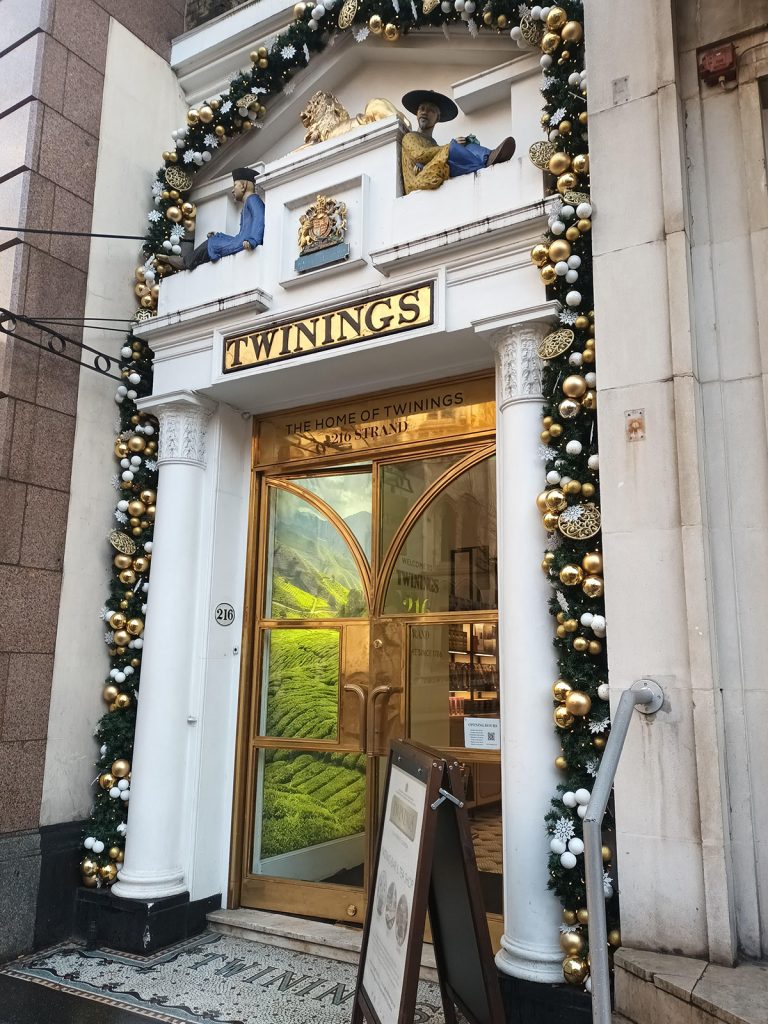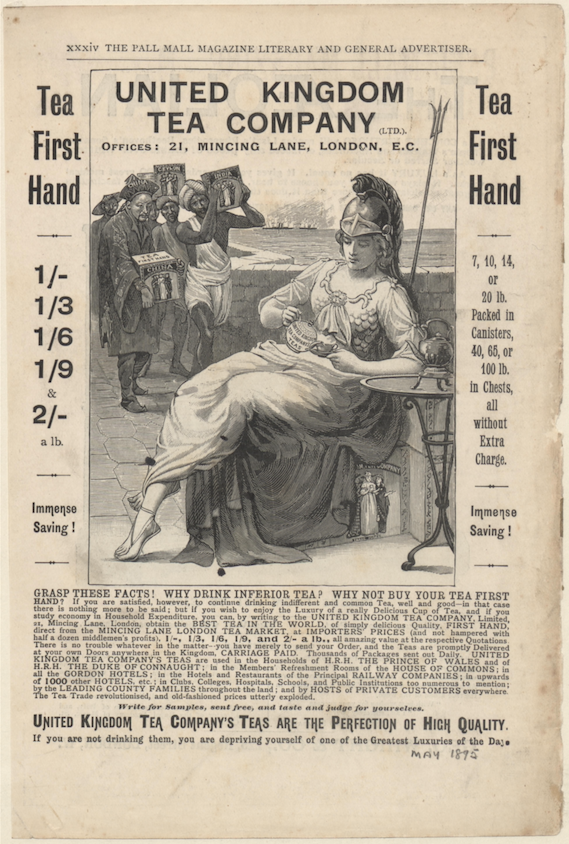‘Polly put the kettle on, we’ll all have tea’: Representing the drink that fuelled an empire
Cathy Turner
In 1658, a new drink was offered at a London coffee-house, advertised as ‘that Excellent, and by all Physicians approved, China Drink, called by the Chinese, Tscha, by other Nations Tay, alias Tee…’ (London Mercurius, Sept 23rd). Samuel Pepys, the diarist, reports drinking it for the first time in 1660, while in 1667, he reports of his wife drinking ‘Tea, a drink which Mr. Pelling the pothecary tells her is good for her for her cold and defluxions’.
Tea, understood initially as a medicinal drink, supposedly became fashionable after Catherine of Braganza married Charles II in 1662, supposedly bringing a casket of tea (as well as the colony of Bombay (Mumbai)) as a wedding gift – which Charles made over to the East India Company for an annual rent of £10 per annum. However, the popularity of tea may not have had much to do with Catherine, since the EIC started importing tea in the 1660s, although the fluctuating tax on it meant it was a drink for the wealthy, initially. Tea auctioning began late in the century, with Chinese tea bought by the East India Company merchants (Besky 2020).
Thomas Twining, employee of an East India Co merchant, Thomas D’aeth, set up the first London coffee house, in 1706. He soon began to specialise in tea and began to sell dry tea, both to other coffee shops and to customers, particularly women, who were not able to visit the coffee houses. His shop at the Golden Lyon, established in 1717, is still there today.

Not everyone was enthusiastic initially. Roy Moxham describes the debates about whether tea was good for you or not, citing the Gentleman’s Magazine in 1737, who described it as ‘warm water bewitch’d with Indian poyson’, while in 1757 Jonas Hanway asked, ‘Were they the sons of tea-sippers, who won the fields of Cressy and Agincourt, or died the Danube’s streams with Gallic blood?’ However, tea became increasingly popular, and still remains a drink associated with British identity (Moxham 2009).
The British put milk in their tea (possibly influenced by Indian tea drinkers) also sugar, reflecting the way British tea is linked to other commodities – sugar, from the Jamaican plantations; chinaware, for drinking it in; silverware for tongs, spoons and caddies. It is also connected to opium.
In the late 17th century, the emerging popularity of tea and other Chinese commodities meant that the EIC became concerned with the outflow of silver to China and the company began growing opium in Bengal, with which to trade with Chinese merchants. This trade grew through the following century, and to such an extent in the 19th century that the Chinese fought the British in two wars, intended to enforce their prohibition of the trade in opium. Weakened by losses, as a result, the Chinese economy was damaged, and Hong Kong was ceded to the British who held it till 1997. Needless to say, the opium trade led to significant loss of lives and livelihood and to addiction and misery in both India and China.
Meanwhile, as the British began to undercut Dutch tea by reducing taxes on tea to America, apart from the resented Townsend Taxes that established the right of Britain to tax the colonies. The ‘Boston Tea Party’ of 1772 involved emptying a shipment of tea into Boston Bay, and the reprisals led to the American Revolution and the Declaration of Independence on July 4th 1776.
Back in Britain, the popularity of tea increased in the 18th century, becoming a popular drink across the social spectrum, though as it was subject to tax, it was often smuggled in. For instance, smugglers picking up tea in Roscoff brought it to Mounts Bay, creating strong trading links between Roscoff and Penzance in the 1770s.
Such smuggling was eventually stopped by a reduction in tea tax from 119% to 12.5% in 1784, but this same Commutation Act also modifed the EIC monopoly, to relate solely to tea imports into Britain.
A 1785 theatrical interlude (by Daniel Defoe’s grandson) called Twisting and Twining, or Tea’s the Twaddle makes direct reference to Twinings, as the farmer explains to his family how to fashionably dismiss these concerns as ‘twaddle’:
When you read in the papers, long puffs setting forth
Of Hysoms and Souchongs and Bohea’s the worth,
With Twistings and Twinings and Tea dealer caveats,
And armies on both sides of bold afidavits,
If asked your opinion of such fiddle faddle,
But turn up your nose. Very Damnable twaddle.
Baker 1785:4
The squabbles over value refer to the EIC need to increase the amount of quality, assorted tea in demand by the British. What was purchased as quality tea in China, might not be assessed as such in London. Sometimes the Chinese would adulterate the tea, or even pack cases with rubbish. Sometimes they would replace it with inferior tea, known as Twankay (a name derived from the Chinese district Tuanxi). Tea dealers, such as Twining, might refuse to pay the company the profits they desired, if the tea was considered to be Twankay rather than Hyson, as he did in December 1784 (Hoh-Cheung and Mui 1963: 244). If the term sounds familiar to British readers, that’s because in the 19th century, Widow Twankay was the name of Aladdin’s mother, in a play by Henry James Byron (1961) and later used in many pantomime versions, now more commonly known as Widow Twankey. The name implied a woman past her prime, in a gesture of casual racism and misogyny.
The social significance of tea in the early 20th century, is wittily suggested by Oscar Wilde, in his play, The Importance of Being Earnest, where tea becomes Cicely’s weapon of choice against her rival, Gwendolen:
CECILY: May I offer you some tea, Miss Fairfax?
GWENDOLEN: [With elaborate politeness.] Thank you. [Aside.] Detestable girl! But I require tea!
CECILY: [Sweetly.] Sugar?
GWENDOLEN: [Superciliously.] No, thank you. Sugar is not fashionable any more.
[CECILY looks angrily at her, takes up the tongs and puts four lumps of sugar into the cup.]
CECILY: [Severely.] Cake or bread and butter?
GWENDOLEN: [In a bored manner.] Bread and butter, please. Cake is rarely seen at the best houses nowadays.
CECILY: [Cuts a very large slice of cake, and puts it on the tray.] Hand that to Miss Fairfax.
[MERRIMAN does so, and goes out with footman. GWENDOLEN drinks the tea and makes a grimace. Puts down cup at once, reaches out her hand to the bread and butter, looks at it, and finds it is cake. Rises in indignation.]
GWENDOLEN: You have filled my tea with lumps of sugar, and though I asked most distinctly for bread and butter, you have given me cake. I am known for the gentleness of my disposition, and the extraordinary sweetness of my nature, but I warn you, Miss Cardew, you may go too far.
CECILY: [Rising.] To save my poor, innocent, trusting boy from the machinations of any other girl there are no lengths to which I would not go.
Wilde 2018 [1899]: Act Two
In the twenty-first century, while much of this remains recognisable, other voices are being heard, pointing to the unacknowledged histories of tea. For instance, Sonali Bhattacharyya’s play, Chasing Hares, draws lines of connection between plantations and factories in Bengal, and the plight of UK Deliveroo drivers. Shown at the Young Vic, in 2022, it was a call to action, just over a hundred years after tea workers protested in the ‘Chargola Exodus’.

Baker, David Erskine (1785), Twisting and Twining, or Tea’s the Twaddle. British Library digitised manuscript.
Besky, S. (2020). Tasting Qualities: The Past and Future of Tea. Berkeley:University of California Press.
Bhattacharyya, Sonali (2022), Chasing Hares. London: Nick Hern Books.
Hoh-Cheung & Lorna H. Mui, 1963. ‘The Commutation Act and the Tea Trade in Britain 1784-1793’ Economic History Review, Economic History Society, vol. 16(2), pages 234-253
Moxham, Roy (2009). A brief history of tea : The extraordinary story of the world’s favourite drink, (Rev. ed.). London: Robinson.
Wilde, Oscar. The Importance of Being Earnest : A Play, Open Road Integrated Media, Inc., 2018.